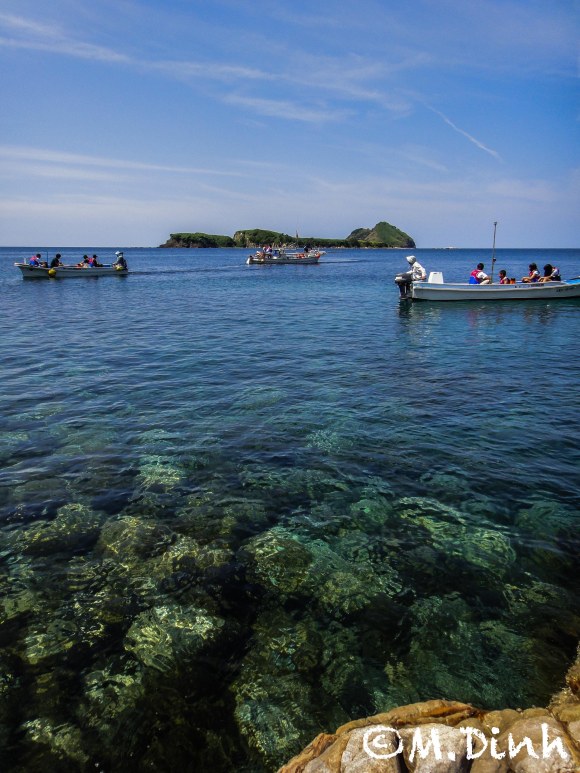
You, Me, And a Tanuki is a weekly featured blog run by Michelle, a Californian who is currently one of only two foreigners living in Chibu, a tiny fishing village on one of the Oki islands in Japan. Check back every Saturday for a new post or read more on her website here!
The most shocking thing I ate when I first came to Chibu (other than salty fermented squid) was sazae. In Japan, people go nuts over this delicacy. In Tokyo, you have to shell out $3 for a single sazae. In Chibu, they are not only free, they are everywhere you look. Climbing up the side of the docks in the evening, hanging out on the ocean floor while you snorkel; there’s plenty to go around. If you’re wondering what a sazae is, here’s a picture:
That’s right, sazae are sea snails. And yes, we eat them here…barbecued, boiled, raw (just grab a rock, smash the little sucker and enjoy!), in curry, in rice, with miso paste, with butter and garlic, the possibilities are endless.
When I was a kid, my dad had three fish tanks. One fresh water and two salt water ones to be exact. I always loved to look at the fish and other creatures in the tank. I remember my dad kept sea snails to help clean off the algae that were constantly growing on the side of the glass and rocks. When I came to Japan and was first handed a sazae and told to use my chopsticks to force the little guy out of his shell, I couldn’t help but flash back to my childhood and the little sea snails that helped to clean my dad’s fish tank.
In this sleepy little fishing village, many old men continue to use a traditional style of fishing called, “kanagi-gyo” (金木魚 in Japanese) to collect sazae from the bottom of the ocean. From the safety of a boat, fishermen use a hydroscope to peer into the water to search for sea creatures. Once they have spotted one, tools attached to long bamboo poles are used to collect sea snails, abalone, seaweed, and even fish from the sea floor. Not only do the fisherman have to maneuver the tools and hydroscope at the same time, they must also steer the boat and stay clear of shallow areas or sea cliffs.
Kanagi-gyo has become less popular in modern times, but the old folks in Chibu are very proud of their fishing tradition and try to pass on the skill to the new generation. The junior high students and I were fortunate enough to be taught this method of fishing from three local fishermen.
The “sazae hoko” is the tool that has three barbs on the end.
The “tamo” is the net tool.
Here’s how it’s done:
Once you’ve spotted a sazae using the hydroscope, use the “sazae hoko” to loosen it from the rock. If the sazae is small enough, you can simply position the barbs of this tool on all sides of the shell, apply a bit of downward force, and sandwich the sazae in between the three barbs. If the sea snail is too large to use this method, you can take out the small net tool, called a “tamo,” and use it to gather the sazae. There are also separate tools for collecting abalone which are also attached to long bamboo poles. The method is similar except you use a long hook-like tool and a shorter barbed tool.
I tried my hand at kanagi-gyo and it was really challenging. Peering over the side of the boat into the hydroscope and trying to maneuver the long bamboo pole into the perfect position, working against the drag of the water, was difficult. Applying just the right amount of force to get the sazae to become wedged between the barbs and not slip away took a very skilled hand (one that I did not possess). But the hardest part (for me only) was not smacking the people around me with the long bamboo pole as I tried to retrieve the stabbed sazae. Instead of adopting the correct method of bringing the pole straight out of the water as I reeled in the sea snail, I decided to take a more dangerous approach and pull the pole in horizontally, smacking a junior high kid on the head. Oops, bad Michelle-sensei. I didn’t do it on purpose and I felt really bad at the time, but looking back, it was pretty funny.
So there you have it, stabbing snails at the bottom of the sea. Who knew this California girl would not only be fishing for sea snails, but cooking and eating them as well!
Michelle is originally from California, but currently living in the tiny fishing village of Chibu, one of the Oki islands in Japan. Being one of two foreigners living in an island village of a little over 600 people presents many adventures. Come back every Saturday for a new article featuring the interesting and bizarre things she comes across in her life in rural Japan. Once a week not enough? Check out her blog, You, Me, And A Tanuki, for photographs and even more articles.
We’re still looking for more unique and interesting stories from Asia to share with the world, so drop us a line if you’d like to have your own blog featured on RocketNews24.